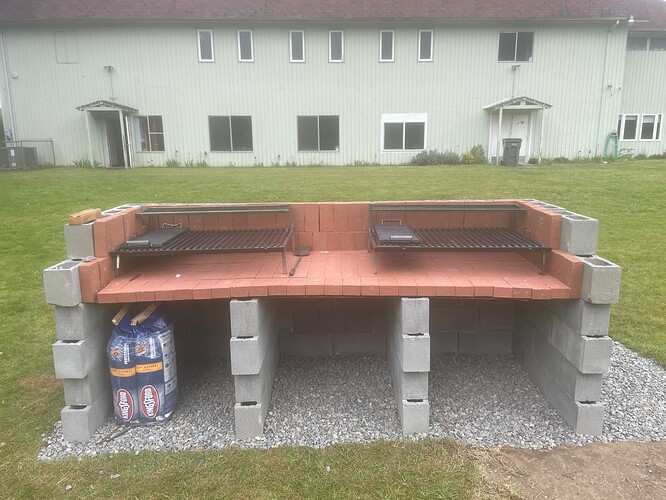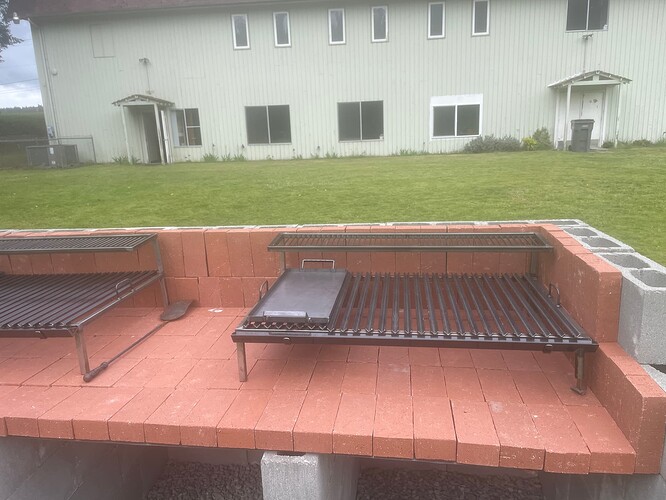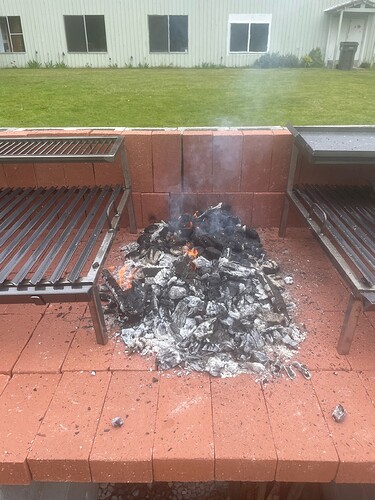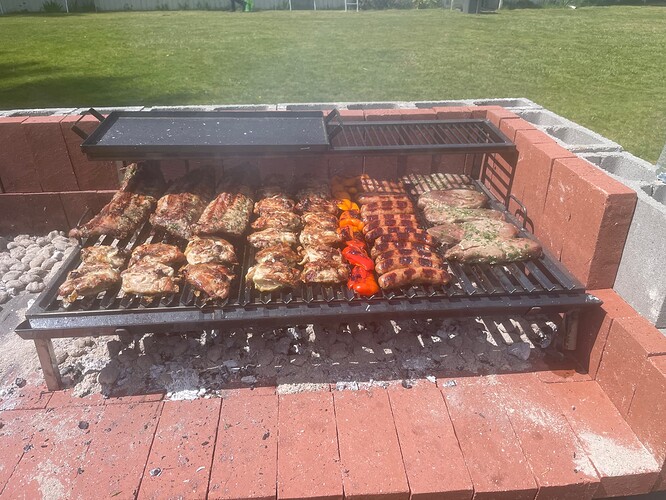We are building a BBQ grill in church (Argentine style, sort of) We wonder if we can use the formula you have for high temp mortar and just put a layer of it on top of a cement slab. (Fire Bricks are way too expensive to cover the slab).
If the above is not a good idea, would regular red bricks work?
If none of the above, what would be an inexpensive way to do it? Basically, we are using cement block that will support a concrete slab array (Each slab 33 x 32 or so) and need to put something on those slabs as we will build the fire on the surface, and distribute embers under the grills.
Thanks for your help!
JC
Hello and welcome to the BrickWood forum!
I applaud the initiative (I’m a certified church guy myself), and…I’m skeptical about whether that would work as you describe it.
I get it about funds, and if what you’re looking for is the glowing embers and flames, you won’t need firebrick for that.
You mention a slab array, which sounds very much like the 3-slab assembly that BWO uses in its hearth designs. I’d suggest this:
- Look at our instructions for casting the concrete slabs, especially the part about using a polystyrene block to create a void in the assembled slabs. That void needs to be the size of your intended cooking surface.
- You will need to put some funds into this. In addition to concrete and the materials for the high temp, you need the polystyrene (foam) insulating sheet, a bag of Portland cement, and a 2 cu yard (not FEET) bag of Perlite. None of those are expensive items.
- Cast your slab array in such a way that you will have an enclosed void when you put them together. Again, see the instructions for the general idea, and adapt it to your dimensions. (For this use, I’m not sure you need the rebar, though rebar also is not terribly expensive. If you can swing it, make a grid whose ends extend just beyond the edges of the void. That will help relieve thermal stress and reduce the chance of cracking.)
- Make the insulating mix of Portland cement and Perlite as described, and pour it into the void leaving about 2 inches from the top surface. Level it and allow it to cure for two days.
- Make the high-temp mortar mix, pour it into the 2-inch void, level with a screed board, and allow to cure for 2 days.
Your first fires will fully cure the high-temp mix rock hard.
This is all based on the idea that you’re not planning to build an oven or any other heavy structure on top of this slab. I’d suggest a clay brick border around the slab to help control air flow and keep burning embers from rolling off the slab.
This definitely feels like MacGyver territory to me, and I’m open to suggestions from the experienced hands on this bulletin board. That being said, I think you’re talking a couple hundred dollars here, and I’m kinda keeping in mind a hope that building this kind of grill might be a gateway to a full-on brick oven in the future. Small starts inspire great ventures!
Please come back if you have questions during your build, and for sure when you’re done to share photos with us.
Ok, Here are some photos. Not finished yet, although we used it. We did a bit of tweaking, lol. We build up with blocks and then used rebard and metal sheet and on top we set clay bricks. We bbqed and it works fine, so now we are going to set the bicks and stuff permanent.
1 Like
Oooohkay, now I see what you mean by “Argentine style.” I’m glad it worked, and it looks like you’ll be able to turn out some serious grill there.
Yes to high-temp mortar. My advice from above still applies: it needs to be heat-cured, hotter the better.
If you decide to go with regular mortar, you won’t need to heat-cure it. But regular red brick will eventually deteriorate over a period of years. I don’t think that’s going to matter here. And Type S will also break down eventually.
The concrete blocks need regular Type S mortar, no need for high-temp. If you want to add a little strength to the structure, sink 4-foot lengths of rebar at the corners, one in the middle on each side, and two spaced across the back. Then fill those cavities with high-strength (4,000 psi) concrete. Each column should take 1-2 bags. That will give you enough anchorage to keep the structure stable.
To avoid unpleasant surprises while cooking, I’d add brick facing on the two inside walls to shore up that heart. Your unmortared version looks like it’s sagging at the ends. Is the sheet metal wedged into the concrete block seam?
I’m a church guy myself, and I applaud your ingenuity on this. Good luck with the permanent build, and let us know how it turns out!
Hey thanks for the input! The sagging at the ends its actually in the middle pillars. There are some rebars under the metal supporting the brick ‘platform’, and while the ends have been “carved into” the blocks, the middle ones have not yet been done, so that should correct the tilting and make it flat leveled. I will keep you updated. In argentina, these are built against walls, and have a chimney built on top, like a fireplace. Sometimes they are built inside a conservatory or gallery of sorts. The secret to Argie BBQing is slow cooking on embers that are added underneath as need, as opposed to the method in the USA where most usually we build a fire and cook on that fire, without many options to regulate take or add fire as needed.
JC
1 Like



